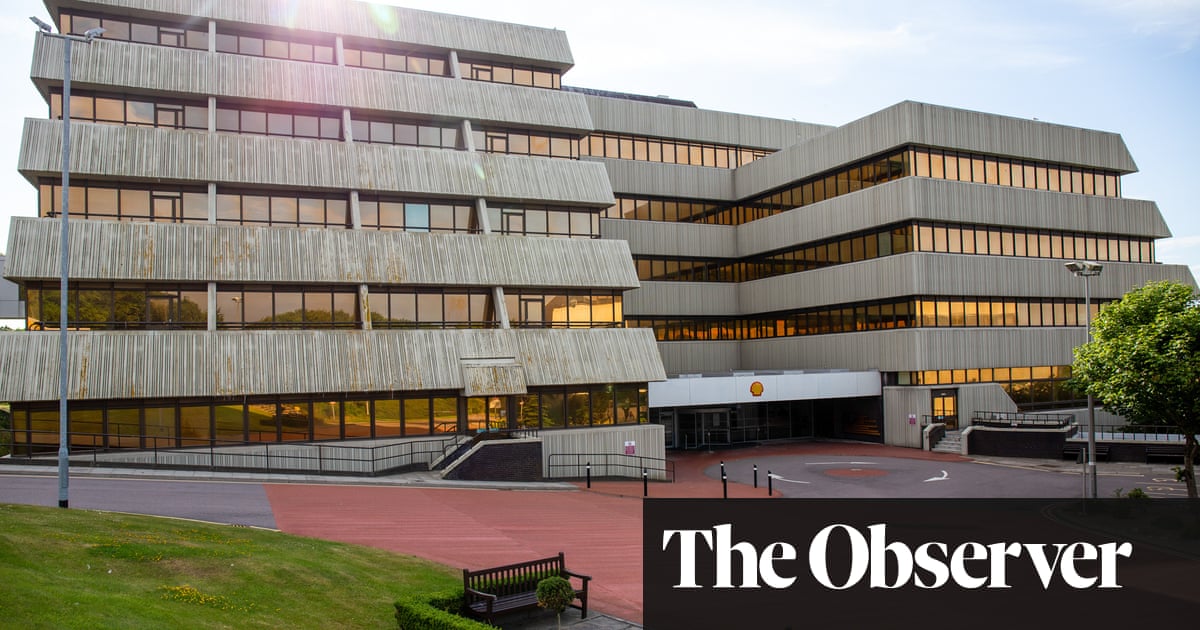
Aberdeen is arguably best known for two things: granite – found in nearby quarries and used to construct almost all of the coastal city’s buildings – and oil. After the discovery of a significant reserve in the North Sea in the 1970s, Aberdeen became known as Europe’s oil capital and a thriving oil and gas industry sprang up in Scotland’s north-east.
At the centre of the boom was the multinational company Shell, which built a five-storey modernist headquarters in the city’s Tullos area, from where it operated for half a century, before moving this year.
Now the building has become the subject of a bitter row after Shell announced its intention to demolish rather than upgrade and repurpose it.
The company notified Aberdeen city council of its plans in mid-July. Since then, an open letter has been signed by more than 40 local architects, academics and climate activists raising concerns about the carbon emissions associated with destroying rather than reusing the building. Shell has not yet revealed its plans for the site.
“The environmental impact assessment conducted for Shell fails to measure or consider the carbon emissions relating to demolition in any way,” reads the letter. “Yet the emissions involved in processing, recycling and transporting all the elements of the demolished building will be vast, especially given the huge amount of concrete in the existing structure.”
Last month, the letter points out, the secretary of state for levelling up, housing and communities, Michael Gove, overruled the planned demolition of the flagship Marks & Spencer store on London’s Oxford Street, in part because of the carbon footprint and environmental implications of destruction.
Doing so saved an estimated 40,000 tonnes of carbon, an amount which could only have been offset by the planting of 2.4m trees.
And while Shell and the council have referred to an assessment which determined demolition as the only feasible plan for the building, this has not been made publicly available, the letter’s signatories claim.
Matthew Clubb, owner of Aberdeen-based architectural design practice mwclubb, and the original writer of the letter, said it was “no surprise” that Shell wanted to demolish the building.
The company has “abandoned a transition to renewable energy in any meaningful way, in favour of climate-wrecking profits,” Clubb said.
“So failing to even measure the emissions from their buildings and construction projects is entirely consistent with that mentality.” He added: “To me, it seems that there are too many people trying to solve the global problem of climate emissions without thinking on the local scale.
“Even if we are to eventually demolish this building, where will we plant the 3m trees that will offset the emissions incurred? How can we delay this action to avoid the short-term emissions spike? We must think long term, beyond the election cycle and beyond the financial forecasts.”
Clubb said his firm worked solely on retrofit projects because of the need to reuse existing buildings if carbon emissions were to be cut.
Another signatory, Richard Laing, professor of urban collaboration at Northumbria University and honorary professor at Aberdeen’s Robert Gordon University, said the carbon emissions associated with demolishing rather than reusing the building were “neither affordable nor acceptable”.
“We need to rapidly move away from an endless cycle of building and demolition and urgently find creative ways in which to repurpose vacant property,” he said.
Both Aberdeen city council and Shell UK have publicly committed to reaching net zero. In March, the council joined a growing number of local authorities in declaring a climate emergency, with council leader Ian Yuill stating it was “committed to playing a full role in tackling these emergencies”.
The letter’s signatories have called for the planning application to be delayed or rejected until further information is made available, including the assessment that determined redevelopment was unfeasible.
They have demanded that Shell carry out another environmental impact assessment, as well as a “life cycle assessment” of all available options for the site. And they have said the public should be invited to submit design and reuse suggestions.
In response, Simon Roddy, Shell UK’s senior vice-president, said: “For decades Tullos was a fantastic home for Shell in Aberdeen. “After completing our move to the Silver Fin Building on Union Street we are evaluating options for the future use of the Tullos site.
Removal of the buildings will help unlock the potential of the site to make a positive contribution to the city.”
A council spokesperson said demolitions of this nature might not require planning consent. They said planning officers had taken part in initial discussions about the site, but not a full assessment of its suitability for reuse.
“The council are in receipt of an environmental impact assessment screening report, which officers are currently working through and will respond to in due course,” the spokesperson said.
Demolition rows
Across the country, a number of debates have emerged about the climate implications of demolishing buildings rather than retrofitting and repurposing them.
Marks & Spencer, London
In March 2021 the retail giant announced plans to demolish and rebuild its largest UK store, on the western end of London’s Oxford Street, following a shift to online shopping during the pandemic. But opposition quickly emerged among architects, climate activists, and even the author Bill Bryson, over the estimated 40,000 tons of carbon which a demolition would release into the environment.
Levelling up secretary Michael Gove announced an inquiry into the plans in 2022, and in July this year he rejected them, suggesting that the company had not sufficiently explored alternatives to demolition.
Wyndford Flats, Glasgow
Plans to knock down four 1960s tower blocks in the north-west of the city have also sparked debate about carbon emissions, with leading Scottish architect Malcolm Fraser among those sounding the alarm over a potential 47,000 tons of embodied carbon. Last month, housing association Wheatley Homes was given permission to proceed with the demolition – but campaigners have announced their plans to pursue a judicial review of the decision.
County Hall, Cardiff
Cardiff council announced its intention in June to replace its current headquarters at County Hall in the city’s Butetown with a smaller building. Opposition quickly followed, with the Twentieth Century Society, a campaigning group which aims to protect Britain’s modern architecture, telling WalesOnline: “the enormous carbon cost of large-scale demolition is simply not compatible” with the council’s climate commitments. The council said that it continued to explore options.












